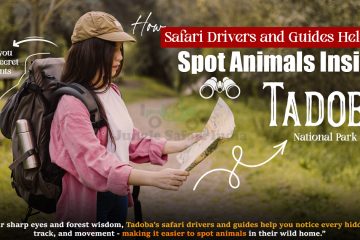Tadoba National Park is a protected forest area that is also known as the Tadoba Andhari Tiger Reserve. This park is one of the most famous wildlife destinations in India, located in Maharashtra. This park is home to a lot of animals like tigers, leopards, deer, sloth bears, and many species of birds. Because of the many animals, this park attracts thousands of tourists every year who come to enjoy safaris, explore the forest, and connect with nature. People make an online Tadoba Safari Booking and through it, they get a chance to enjoy a safari at this wild spot.
However, because of the growing tourism, the responsibility to protect the natural environment is on the forest department. Too many visitors can disturb the wildlife, and this can also harm the natural habitat of those animals. To handle the tourists and to protect the environment, the Tadoba National Park follows the eco-tourism practices. Through this, people can enjoy the beauty of the forest and explore it while protecting the environment. Let’s know how Tadoba National Park protects nature while welcoming tourists:
What Tadoba Follows
The forest department of Tadoba National Park follows the Eco-tourism, which simply means responsible travel to natural areas where the focus is not only on enjoying the beauty of nature but also on protecting it. In Tadoba, eco-tourism helps both the forest and the people living around it.
The main goal of eco-tourism in Tadoba is to:
- Protect wildlife and forest ecosystems.
- Support local communities by giving them job opportunities.
- Educate visitors about conservation and wildlife behavior.
- Encourage sustainable tourism practices that do not harm the environment.
How Tadoba Protects Nature While Promoting Tourism
1. Safari Zones
The Tadoba National Park is divided into safari zones. These zones help the park to control the number of tourists going for rides inside the park. In a particular zone, a particular number of tourists can go. The Forest Department has set a limit on gypsy safaris and the number of tourists who can visit the particular zone. Each safari that goes inside the park follows a fixed route and time, which ensures that there is no overcrowding of tourists.
This way, the forest department protects the natural habitat of animals, and the wildlife of the park does not get disturbed. With this controlled entry system, the Tadoba National Park is giving an opportunity to tourists to go inside the park and is also protecting the wildlife. You can make an online Tadoba Safari Booking for any core or buffer zone of the park.
2. Rules During Tadoba SafarisÂ
The Forest Department offers a thrilling gypsy safari experience to tourists, but there are some rules and regulations that people have to follow. These rules and regulations not only protect the natural habitat, but they are also important for the safety of the tourists. Some basic rules are
- No loud talking or music inside the park.
- No feeding or teasing the animals.
- Keeping a safe distance from wildlife.
- Not littering or throwing plastic items in the forest.
- No alcohol or smoking allowed.
These rules allow tourists to enjoy exploring the park without harming the animals or disturbing the natural forest. To make sure that these rules are being followed, the forest guides and trained drivers go on safari with the tourists. They make the safari both enjoyable and educational for the tourist.
3. Wildlife Monitoring
The forest department of Tadoba continuously watches the wildlife of the park. They do it through camera traps, GPS tracking, and data analysis. This helps them to learn about the animals’ movement inside the park, and then they can decide the buffer and core zones of the park. This wildlife monitoring research helps the authorities to understand which areas should remain undisturbed and which zones can be booked for the safe safari rides.
The wildlife monitoring also helps the forest department to track the growth of the tiger population and ensure that eco-tourism does not harm the natural habitat of the park. For example, if a larger number of tiger movements is detected in a particular area. Then authorities might contact the driver or guide and stop the safari from going there for the safety of humans and animals. This basically helps the departed to protect both the wildlife and the visitor experience.
4. Educating Visitors
This is another way through which the forest department of the park protects nature while promoting tourism. In this, the park authorities basically make sure that tourists understand the importance of eco-tourism and responsible behavior before entering the park. This is done by installing information boards, visitor centers, and mentioning the rules of going on a safari.
This is also done through telling the visitors about the do’s and don’ts before they enter the park. Before the safari starts, the forest guides brief the tourists about:
- The importance of keeping the forest clean.
- Not using plastic items inside the park.
- Respecting wildlife and following the silence rules.
- Understanding how tourism helps conservation when done responsibly.
- How to behave in front of animals.
When tourists are briefed about these points, they act more responsibly during the ride. When the tourists follow these pointers, they can enjoy a safer and exciting safari time. These directly support the protection efforts of the park.
5. Limited Construction and Vehicle Control
The forest department of Tadoba also controls the number of resorts and buildings that can be made near the park. Overconstruction of buildings or a larger number of resorts can disturb the natural environment of the area, which can lead to problems for the wild animals and birds. If you wanna build a hotel or resort near the park, then you might have to take permission from the park authorities or the government.Â
Also, only a limited number of vehicles can go inside the Tadoba National Park in a day. The park allows a particular number of gypsies to go inside it at a particular time in a day. The timings for morning and evening safaris are fixed to give animals peaceful space in between them. This ensures that the animals get to live in natural environments and they don’t get disturbed by humans or vehicles.



0 Comments